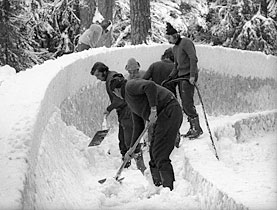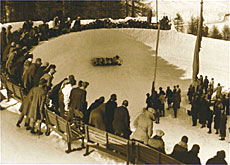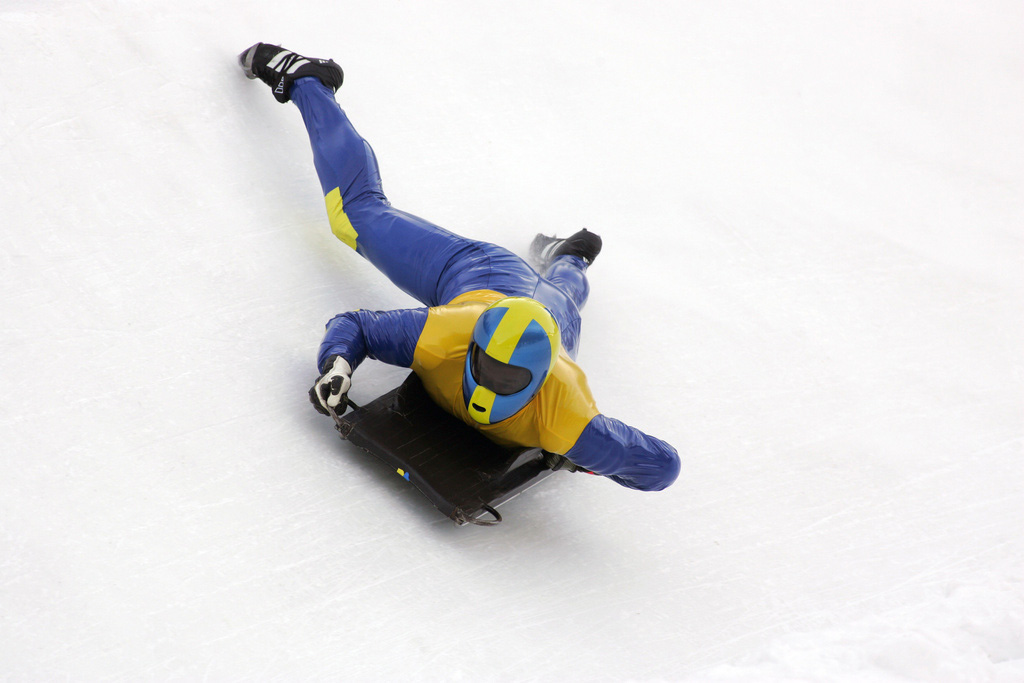Maintaining a record-breaking run

It’s over 60 years since St Moritz last hosted the Winter Olympics, but the bob run in the eastern Swiss resort is still a record holder.
Not only does it have the oldest bob run in the world, but it is the only one still built of natural ice. Christian Brantschen has been in charge of it for 20 years, and he told swissinfo.ch how it all works.
“There is a huge difference between St Moritz and the other runs. The run from St Moritz down to Celerina is part of the slope, so you really are out in natural surroundings.
Every winter a new natural ice track is built out of snow and covered in water which then freezes. On the other hand, an artificial ice track is a pre-existing concrete structure, to which a four to six centimetre thick layer of ice is then applied.
We always start building in the last week of November. There are 15 of us in the team, we all work well together, with everyone knowing where he has to be.
What’s special is that the team which builds the track has been together for decades. Almost without exception all the members come from Naturns in the south Tyrol. In the winter they work on the construction and maintenance of the track, and in summer they work back home, on building sites, forest wardens, or looking after animals up in the mountains.
Putting the brakes on
First of all we collect the snow. If none has yet fallen, we make it ourselves by using snow cannon. Then the track is staked out in sectors, for the rough building. Then the second phase is to create the details, like the curves and banking slopes. And then the track is put together, section by section. People can start using it around Christmas.
Sunny Corner and the Horse Shoe are more challenging for the athletes than for us, because it’s the wider curves with bigger radiuses that are harder to build.
The Horse Shoe became too dangerous, so in 1996 we had to increase the radius from 15 to 18 metres – the forces had become so great that the runners of the bobs were cutting grooves into the track. As speeds increased, the finish was no longer suitable. Today the end is a 300 metre long straight, which climbs slightly.
Top quality ice
As far as the quality of the ice is concerned, we meet international standards. St Moritz is equal to any artificial ice track, or even better. The ice is improving, not least thanks to our tools. We plane the ice in exactly the same way that they do on artificial runs.
I know the run not only as a builder, but also from the viewpoint of the pilots. But I’ve been the driver only in older bobs. In the newer ones I’ve only been a passenger. But of course I’m very familiar with the neighbouring Cresta run, because my original sport was the skeleton.
The Olympia run gives you a special feeling because you are subjected to huge centrifugal forces – so called G-forces. Then of course you have the speed – the fastest four-man bobs today get up to nearly 150 kilometres an hour!
Climate change
Climate change is something we are all worried about, me in particular. I’ve been close to the Cresta Run and the bob track every day in winter for more than 30 years. You feel the changes. The changes of temperature are more marked and occur more quickly now than they used to.
But we are 1,800 metres above sea level, and it will take some time before the run is threatened. And then, thanks to cannon we can now make the snow ourselves. This is even better than natural snow, because it is much longer lasting.
The season ends in the first week of March. Then we spend a couple of days clearing up before everyone goes back home.”
Christian Brantschen spoke to Renat Künzi, swissinfo.ch
The first race on the St Moritz Olympia Bob Run was held on January 1, 1904.
The run is 1,722m long, with a height difference of 129m, giving it an average gradient of 8.1%.
It is still built by hand: the 15-man team uses 5,000m3 of snow and 4,000 m3 of water.
It is rebuilt from scratch every year, which means that there are small changes in the track each time.
Nevertheless, the main outlines remain unchanged. But because the bobs have grown faster and faster, the radius of several curves have had to be enlarged.
The names of the run’s 19 turns are testament to the very British beginnings of the sport: they include “Wall”, “Snake”, “Horseshoe”, “Shamrock” and “Leap”.
The bobs reach top speeds of up nearly 150km/h.
The bobsleigh is one of three Olympic sliding sports (with skeleton and luge).
They can be raced with four or two men.
The track twists and turns down an incline.
To start, the racers build up momentum by pushing off as fast as possible for about 50m, then jump in and descend seated.
The driver, or frontman, steers while the brakeman at the back is responsible for stopping it at the end. In a four-man bob two crew members sit between them, lending weight, and therefore increasing its speed.

In compliance with the JTI standards
More: SWI swissinfo.ch certified by the Journalism Trust Initiative


You can find an overview of ongoing debates with our journalists here. Please join us!
If you want to start a conversation about a topic raised in this article or want to report factual errors, email us at english@swissinfo.ch.